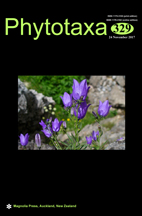Abstract
Circinella (Mucorales, Mucoromycotina) is morphologically similar to Mucor, differing by the production of circinate sporangiophores and sporangia with a persistent and incrusted sporangial wall. During a study on the diversity of Mucorales in areas of the Atlantic Rainforest in Brazil, we isolated a strain that fits the current morphological concept of C. simplex of Hesseltine and Fennell (1955) by forming simple circinate sporangiophores with secondary branches and angular sporangiospores. Molecular phylogenetic analyses based on three different markers (ITS, LSU and MCM7) confirmed conspecificity of the Brazilian strain with other angular spored strains of the CBS collection including the strain studied by Hesseltine & Fennell (1955). The molecular phylogenetic analyses clearly placed these strains in the genus Mucor in the close relationship to M. laxorrhizus and M. fuscus. However, in his original description van Tieghem (1875) described and illustrated C. simplex with sporangiophores without secondary branches and globose sporangiospores. Based on these striking morphological differences combined with a differing geographic distribution, we conclude that the angular-spored strains represent a separate undescribed species for which we propose the name Mucor circinatus sp. nov.

